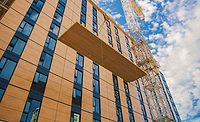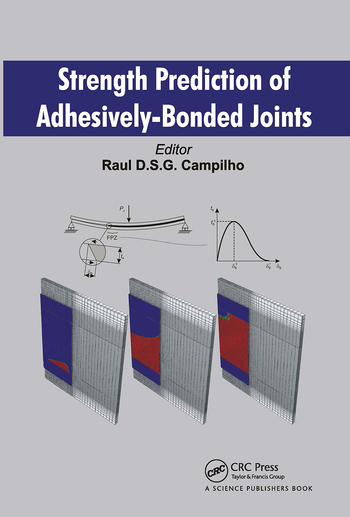Growing Landscape of Cross-Laminated Timber
Cross-laminated timber combines structural strength, eco-friendliness, and architectural flexibility.

courtesy of zefart / iStock / Getty Images Plus.
In a world increasingly focused on sustainability, the cross-laminated timber industry is emerging as a force reshaping how we build. The product combines structural strength, eco-friendliness, and architectural flexibility. With its renewable composition and efficient construction methods, it is helping to build a greener, faster, and more versatile future for the construction landscape.
Advantages
The cross-laminated timber industry boasts several advantages that contribute to its growing prominence in the construction sector:
- Sustainability: Cross-laminated timber is crafted from sustainably harvested wood, promoting eco-friendly construction and reducing the industry’s reliance on non-renewable materials.
- Lightweight construction: Cross-laminated timber’s high strength-to-weight ratio facilitates the construction of taller buildings without the excessive load associated with traditional materials.
- Enhanced seismic performance: Cross-laminated timber’s inherent flexibility and strength make it an ideal material for seismic-resistant construction, providing safety benefits in earthquake-prone regions.
- Adaptability to various climates: Cross-laminated timber performs well in different climates, offering a versatile solution for construction projects in diverse geographical locations.
- Fire performance: When properly designed and treated, cross-laminated timber exhibits good fire resistance, and research continues to enhance its fire safety properties.
Environmental Benefits
Designers, builders, and other stakeholders in the construction industry are making efforts to reduce their environmental footprint by integrating renewable materials and sustainable design into their projects. This is primarily because construction contributes to almost 40% of global carbon emissions, which is one of the primary drivers of human-induced climate change. Cross-laminated timber is emerging as a popular material of choice for both residential and commercial structures. It is made of wood, which can store carbon during the building's lifetime and capture additional carbon. Researchers have found that a hybrid, mid-rise cross-laminated timber commercial building can provide a 15-26% reduction in global warming potential, depending on the building design.1
Market Scope
The cross-laminated timber industry is expected to exceed $7 billion by the end of 2036, with a growth rate of 14% during the forecast period from 2023 to 2036. In 2023, the industry size of cross-laminated timbers was already over $2 billion. This growth is estimated to be due to the increasing need for cross-laminated timbers to address global rising pollution levels. The use of cross-laminated timber helps reduce carbon emissions during the construction process and promotes the use of renewable resources. In 2022, renewable sources contributed 13.1% of the total energy consumption in the United States, indicating a growing demand for renewable energy sources.2 This growing demand is also driving the market for cross-laminated timber.
Other market drivers include:
- Sustainability: Growing environmental awareness and a focus on sustainable construction drive the demand for cross-laminated timber, as it is a renewable resource with a lower carbon footprint compared to traditional building materials.
- Speed and efficiency: Cross-laminated timber’s off-site prefabrication capabilities lead to faster construction, reducing project durations and labor costs. This efficiency appeals to developers and contributes to market growth.
- Urbanization trends: As urbanization continues globally, cross-laminated timber’s lightweight nature and ability to enable taller wooden structures cater to the demand for sustainable, high-density urban development.
- Architectural flexibility: The ability of cross-laminated timber to support innovative designs and its structural versatility make it attractive to architects, fostering increased adoption for a wide range of building types and styles.
- Government support and policies: Supportive government policies, incentives, and regulations promoting sustainable construction materials encourage the use of cross-laminated timber, driving market growth and fostering a favorable environment for stakeholders. For instance, the 2015 Paris Climate Agreement requires the worldwide concrete industry to cut its emissions by 16% by 2030 and 100% by 2050.3
Challenges and Potential Solutions:
Stringent building codes and regulations may limit the use of cross-laminated timber in some regions, posing hurdles to widespread adoption. One solution is to collaborate with regulatory bodies to develop and update codes that reflect the unique properties of cross-laminated timber. Advocate for the inclusion of cross-laminated timber in building standards through industry alliances and research-based evidence.
Fire safety is also a significant concern for tall timber buildings, and misconceptions about the fire resistance of cross-laminated timber may hinder its acceptance. Among the solutions to this challenge is to conduct extensive research on fire-resistant treatments for cross-laminated timber. Engage in educational initiatives to dispel myths and promote awareness of the technology's actual fire performance. Develop and implement fire safety design strategies for cross-laminated timber structures.
The growing demand for cross-laminated timber may strain the supply chain, leading to potential delays and increased demand. The industry needs to invest in expanding production capacity and optimizing supply chain logistics, and foster collaborations between cross-laminated timber manufacturers, timber producers, and construction companies to ensure a robust and efficient supply chain. Continuous improvement in manufacturing processes can help meet increasing demand
Regional Analysis
The cross-laminated timber market exhibits diverse regional trends, reflecting varying degrees of adoption, regulatory landscapes, and market maturity. Asia-Pacific is witnessing robust growth in the cross-laminated timber market, driven by increasing urbanization, a rising focus on sustainable construction, and government initiatives promoting eco-friendly building materials. Factors impacting this growth include increasing populations, rapid urban development, and a shift towards green building practices contribute to the demand for cross-laminated timber in countries like Japan, China, and Australia.
In North America, the region has embraced cross-laminated timber, with the market gaining traction in the United States and Canada. The region is witnessing a surge in cross-laminated timber adoption due to a strong emphasis on sustainability, coupled with increasing awareness and acceptance. Among the factors leading to an increase use of cross-laminated timber in North America, is its ability to meet stringent building codes and support for the product from government policies.
Europe is at the forefront of the cross-laminated timber revolution, with well-established markets in countries like Austria, Germany, and the Nordic region, the market has matured, and cross-laminated timber is widely accepted as a mainstream construction material. Strong environmental consciousness, support from regulatory bodies, and history of timber construction traditions drive the thriving cross-laminated timber market in the region.
Outlook
The market for cross-laminated timber is expected to expand further due to the growing emphasis on low-carbon building materials, greater urbanization, and sustainable construction methods. The evolution of the market in the future will be shaped by ongoing technological advancements, sustained collaboration, and the establishment of increasingly thorough regulatory frameworks.
The way the cross-laminated timber market has developed shows how a dynamic business is adapting to the needs of contemporary construction techniques that emphasize efficiency, sustainability, and innovation. The market will probably become more significant in determining how urban development is developed globally in the future as it continues to change.
Impact on Adhesives Industry
The increasing use of cross-laminated timber within the construction industry has a direct impact on the adhesives market. Because adhesives are used in the production of cross-laminated timber, demand for these adhesives, such as one-component polyurethanes, will increase. As this sustainable building product increases in popularity, it will replace the use of more traditional materials, such as steel and concrete, which are less dependent on adhesive technology for their production and use. Additionally, advancements in adhesive technology can go hand-in-hand with other technologies involved in the production of cross-laminated timber.
Conclusion
The cross-laminated timber industry is leading the way in sustainable and eco-conscious construction practices by offering an innovative and environmentally friendly alternative to traditional building materials. With its exceptional strength, design versatility, and sustainability, CLT is reshaping the construction landscape and becoming a pivotal player in achieving sustainability and eco-friendly goals worldwide.
Learn more about the cross-laminated timber industry by reading this market report at https://www.researchnester.com/reports/cross-laminated-timber-market/5342.
References:
- Moore, A. (2024, Feb. 9). 5 Benefits of Building with Cross-Laminated Timber. College of Natural Resources. News; https://cnr.ncsu.edu/news/2022/08/5-benefits-cross-laminated-timber/#:~:text=Because%20CLT%20is%20made%20of,depending%20on%20the%20building%20design
- Ukpanah, I. (2024, Feb. 9). Renewable Energy Transition: A Comparative Analysis of US vs UK. GreenMatch. https://www.greenmatch.co.uk/renewable-energy-transition-outlook
Looking for a reprint of this article?
From high-res PDFs to custom plaques, order your copy today!








